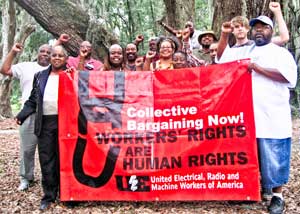Solidarity school forges Southern workers’ unity
By
Dante Strobino
St. Helena Island, S.C.
Published Oct 10, 2008 11:13 PM
From Sept. 18 to 21 dozens of working-class fighters from unions,
workers’ centers, anti-gentrification organizations and academia attended
the Southern Solidarity School in St. Helena Island, S.C., to build unity among
Southern workers fighting for democratic, rank-and-file, struggle-oriented
organizations.
|
Workers and activists at labor school.
WW photo
|
According to the Center for Labor Renewal, which organized the school,
“Some of our working class organizations are trying new approaches, but
they remain small, mostly local in scope, and face contradictions of their
own.
“The crisis demands bold initiatives that focus on transformation of
existing worker institutions, building an all-inclusive movement, and powerful
social mobilization for economic and cultural justice.”
Delegations came from Longshoremen’s Local 1422, the Charleston dock
workers, home of the Charleston 5; Electrical Workers’ Local 150, the
North Carolina Public Service Workers Union; the Food and Commercial
Workers’ Justice at Smithfield Campaign; and the Freightliner 5, five
fired members of Auto Workers’ Local 3520 in Cleveland, N.C.
Representatives of Black Workers for Justice, Power U from Miami, and U.S.
Labor Against the War attended, as did several workers currently on strike at
the Moncure Plywood factory organized by Machinists’ Local W369 in rural
Chatham County in North Carolina. Other unionists came from Texas, Arizona and
Georgia.
Workers were there to learn about labor history in the South. Kerry Taylor from
the Citadel gave a powerful presentation about three critical strikes in
low-country South Carolina. First was the story of more than 4,000
African-American laborers in the rice fields in Beaufort who struck in 1876
while the post-Reconstruction economy was in shambles.
Second was the 1945 strike in Charleston at the American Tobacco Company, led
by thousands of African-American women, who were later joined by 200 white
women. This strike inspired the song “We Shall Overcome,” which
later became the anthem of the Civil Rights Movement. Third was the 1969
Charleston hospital workers’ walkout against racism and being paid wages
below the federal minimum.
The workers’ school was brought to the South by the Center for Labor
Renewal, launched in 2006, which has set up similar schools in the Midwest and
Northeast.
All 13 Southern states combined have fewer union members than the state of New
York, making the region of strategic importance for labor organizing.
Participants heard a compelling presentation by the Institute for Southern
Studies, which pointed out that the South has the largest-growing population in
the country. South Carolina also has the largest-growing immigrant population,
followed by Tennessee and North Carolina.
The Southern Studies speaker noted that Charlotte, N.C., is the headquarters of
such finance capital giants as Bank of America and Wachovia, and housing
foreclosures disproportionately affect home owners in the South.
The speaker also pointed to the South’s importance to the
military-industrial complex, with 35 to 45 percent of troops coming from the
region and 56 percent currently stationed there.
Among many other important discussions was one about race lead by Bill Fletcher
of the Center for Labor Renewal. He went into the historical development of the
“white” race and gave examples of why “race is never
static.”
At another session on understanding Black and Brown unity, facilitated by
Janieve Williams of the Latin American and Caribbean Community Center, workers
were able to challenge ideas about immigrant workers which the bosses spread to
create disunity. Participants also talked in depth about migration due to
imperialism.
The conference ended with a long strategy session where workers shared their
struggles and discussed how to build support for each other.
Saladin Muhammad, an organizer with the International Workers Justice Campaign
of UE, described the Southern Solidarity School as “an important
opportunity to bring workers and activists from around the U.S. South together
to discuss critical and sensitive questions related to organizing the
South.
“The presence and participation of rank-and-file workers and members of
the North Carolina Public Service Workers Union UE Local 150 and IAM Local W369
from eight different workplaces in the state, and Charleston, S.C., dockworker
members of ILA Local 1422 provided rich lessons, social bonding and a spirit of
worker solidarity.”
According to Shannon Reaze, a community organizer in Miami with Power U,
“The school was important for building new ideas and relationships that
can take the social labor movement to the next level in combating
neo-liberalism.”
Reaze added, “The global South and the Southern region of the U.S. must
see their relationship to one another. Youth are the ones who can carry that
torch the furthest. The Solidarity School was a great place for young community
and labor organizers to take up that mission and have our elders there to guide
us.”
Articles copyright 1995-2012 Workers World.
Verbatim copying and distribution of this entire article is permitted in any medium without royalty provided this notice is preserved.
Workers World, 55 W. 17 St., NY, NY 10011
Email:
[email protected]
Subscribe
[email protected]
Support independent news
DONATE


